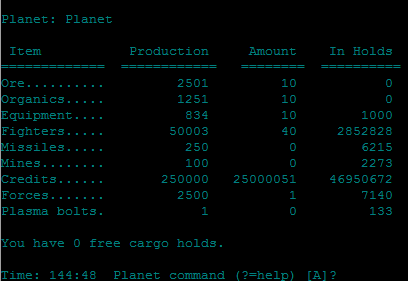Planets are the key to wealth and victory in Yankee Trader as they produce almost every single resource you will ever use up or need. Basically your planets make everything for you and everything is produced over time. If you have a lot of good planets your score will increase dramatically every day. Your job is to make good planets and let them produce fighters, missiles, plasma bolts for you, and to keep your planets protected and secret from other players. If you are killed in competition with other players and all but one of your planets is taken away, that one planet you have left should let you rebound very quickly and give you the resources to restock your ship and take other planets back again.
Here is an example of a very rich and well developed planet:
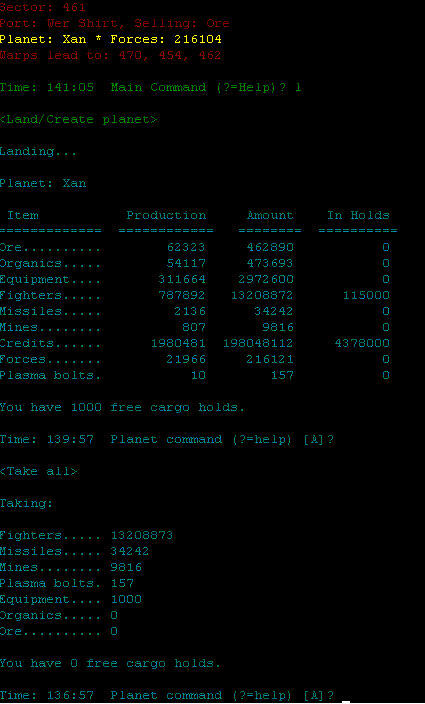
Note that this planet has been moved outside of a dead end sector in order to sell equipment to the port as it probably exhausted the demand for equipment in it’s original port.
Planets develop in three different ways.
The first way is to transfer cargo directly to the planet. Daily production of that type of cargo is increased permanently to 1/10 of the amount of cargo on the planet. This is the same way that planets increase their own production continuously. If cargo remains untouched on the planet then that planets production will increase continuously at a rate of 10% per day. Because equipment is the most valuable cargo to sell it makes sense that if this procedure is followed, equipment should be the type of cargo transfered to the planet and given enough time that planet will produce an unlimited amount of equipment (spread out across days) for you to sell.
Macro (F8): L;T;C;P;;/R20
Remember you can find the port selling equipment and create your planet there, and later move it to a dead-end sector.
A more inpatient method and one that will yield up a much much greater quantity of fighter production is to purchase production directly ($) via spending credits on it. This does not use up turns unlike buying cargo and transfering it, and is cheaper only if the cost per unit to buy cargo from the port is less then 9 credits each. Because it does not use turns to increase production, is by far the most efficient way to build up a planet. Because of the incredible offensive value of plasma bolts, any money spent on a planet should at least and at most increases it’s overall production in units of 100,000. If you have a new planet, always spend 8,333,250 credits on it. If you have a planet that already has minor production already, use the player spreadsheet at the top of this document to calculate exactly how much money needs to be spent in order to get to the breakpoint needed to produce one plasma bolt per day.
Yet a third method is to leave credits sitting in the bank and hope that a competing player does not steal the planet from you and take the credits. This is essential to produce missiles and mines, as can be seen by the table below. Fighters and plasma bolts are much easier to create with planet production.
After spending 8,333,250 credits: ($)
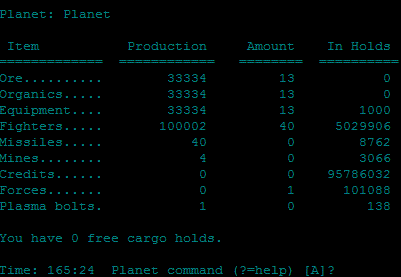
(Note that ground forces increase at a rate of 1%. Storing credits is a much faster way of generating ground forces)
After depositing 25 million credits in the bank:
| per 60,000 production points or 5,000,000 credits spent | per 5,000,000 banked | Score Value | |
|---|---|---|---|
| Ore | 20,000 | 1000 | 20 |
| Organics | 20,000 | 250 | 30 |
| Equipment | 20,000 | 167 | 40 |
| Fighters | 60,000 | 10,000 | 100 |
| Missiles | 24 | 50 | 1000 |
| Mines | 2 | 20 | 2500 |
| Credits | 0 | 50,000 | 1 |
| Ground forces | 0 | 500 | 750 |
| Plasma bolts | 0.6 (1 per 100k prod) | 0.2 (1 per 25 mil) | 1,000,000 |
An example of an extremely rich planet:

To ensure that any single planet does not become too powerful, plagues occur randomly in planets with as little as 169,000 productivity up to over 1.5 million productivity and will reduce both the amount of productivity and the number of ground forces down anywhere from 1% to 99%, the amount of reduction completely random and independent of each other. Old planets and ports in old games tend to list high quantities of one commodity and extremely low quantities in the others.
If a planet has more then 1 million ground forces on it, every day there is a random chance of a civil war occurring regardless of planetary production. The operation of a civil war is identical to a plague except that it also reduces the credits stored in the planet’s bank 1% to 99% as well. If the planet contains no money, a civil war only reduces planetary production and ground forces. If the planet has over 2 million ground forces, civil wars will be triggered every single day no matter what the planet production is. Civil wars create interesting display bugs in another way: (credits are not actually removed from the plague planets)
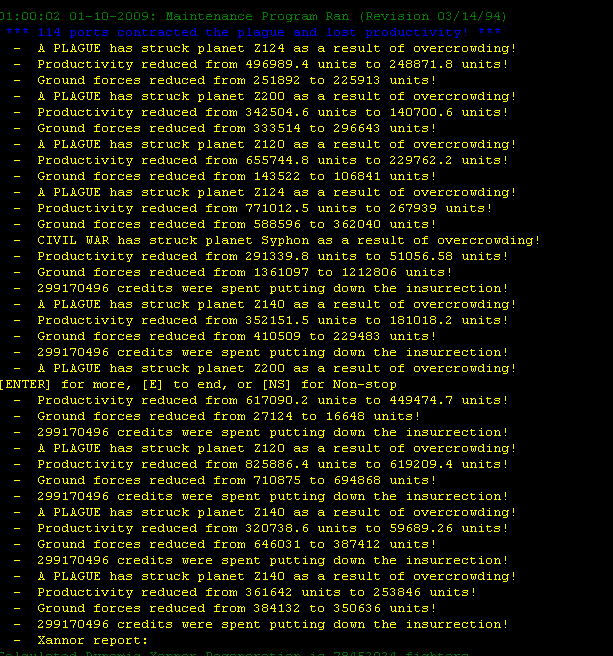
The degree that you choose to develop your planets is up to you. As a simple moneymaker it makes more sense to transfer equipment in mass from a port that sells it cheaply to a planet, move the planet to a sector where a port will buy it expensively and sell it all off. Throw a few ground forces and money (to grow the ground forces) on the planet and abandon it in a dead end sector for a few days to weeks later you will have a valuable planet filled with resources to sell off.
Spreading resources between many different planets ensures that theft or destruction by another player will not bankrupt you if they find your single planet. Alternatively on long-term basis a large number of planets has more potential to grow before hitting the artificial productivity cap also known as plagues.
L;3;;P;;;0/R20 = Sell equipment from planet to port, transfer whatever the port is selling back to the planet
L;2;;P;;;0/R20 = Sell organics from planet to port, transfer whatever the port is selling back to the planet
L;1;;P;;;0/R20 = Sell ore from planet to port, transfer whatever the port is selling back to the planet
Once a planet is well developed and very well defended, you may exhaust the current port’s ability to purchase trade goods from it. When this happens you can either abandoned it to develop fighters/missiles/plasma bolts on its own and move to a new planet, or you can move the planet to a new location.
It is very dangerous to store money on a planet not in a dead-end sector!
It is always safest to put your planet at the very end of a dead end sector “chain” because if there is a sector “beyond” your sector you have statistically twice the chance for that planet to be hit with missiles fired by Xannor or other players.
As described in later sections concerning the Xannor, it’s best to store money on a planet in a dead end sector when the number of ground forces X 50,000 exceeds the score of the Xannor or you risk the possibility of the planet being destroyed by an unfortunate wave of Xannor groups all attacking your planet at once. When starting out there is no way to completely eliminate this risk. You must decide on putting all your eggs in one well secured basket or spreading your ground forces thin between a larger number of planets.
Port inventories of both items for sale and items to purchase grow at a rate of 10% per day. For this reason it is important not to exhaust the capacity of the port in that dead end sector where your planet is! Move on, find new dead end sectors, create new planets, and return much later and you will be able to sell off another massive load of cargo to the port later. Also keep in mind that once the sum of all items at port reaches 10 million, the port contracts the plague and these items are significantly reduced and possibly the item the port has for sale will change.
Moving a planet is moderately dangerous. As there is a slight chance of the planet exploding, first remove all ground forces and money from the bank. Planet explosions also destroy roughly 10% to 50% of your fighters so it would not hurt to leave all of them defending a sector first. Planets will also explode if they are moved into other planets so it does not hurt to first travel to the sector yourself first. Planet explosions will never kill a player so there is no danger in leaving all of your defensive fighters elsewhere. If you want to destroy a planet intentionally without expending missiles or plasma bolts or revealing the location on the newspaper, then create a planet in the next sector, place all of your defensive fighters in defense of the sector, and move the planet into the empty one on purpose. Here is an example of a planet explosion:
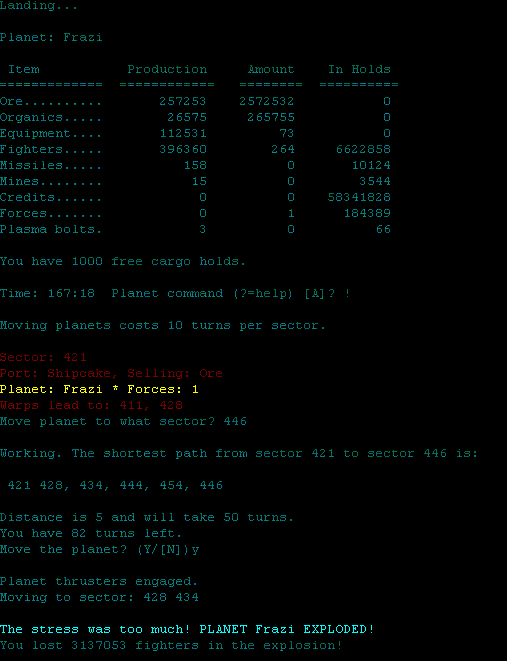
To decide where to move the planet, check your computer's nearest ports: c;14;

If you find a port (for example one buying equipment at a good price) also check to make sure that the port will buy a large enough quantity to make the move worthwhile. Again you can view a port by the command: C;2;[port number]
Alternatively you can create a large number of planets in dead-end sectors containing ports selling ore or organics (buying equipment) and just cycle through them when the one you are currently at is exhausted. Make sure that you give the port enough time to recover.
At most 100 planets may exist in one game:
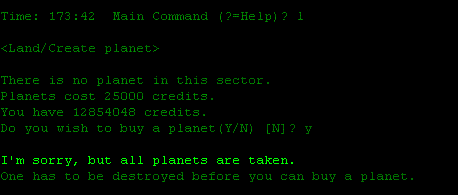
Capturing planets with ground forces typically requires equal or more ground forces than the planet itself has. Simply attempt to land on a hostile planet to get the choice to attack with ground forces. Each side, typically the defenders first, will get an opportunity to reduce the numbers of the other side. Using an overwhelming number of ground forces can often obliterate all opposition without the defenders having any chance to retaliate or retaliate significantly.
There are very rare exceptions such as this:
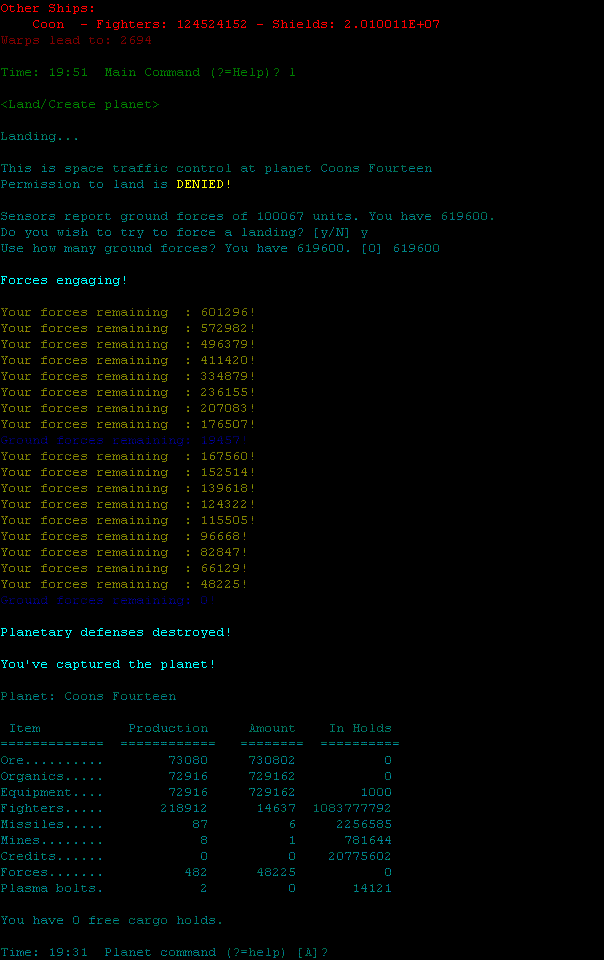
To use plasma bolts to cut down the number of ground forces without destroying the planet, first fire one plasma bolt at the planet to see what the planet’s current production is. Next assuming that your plasma bolts will do the maximum 3000 * PB^2 damage, calculate either by formula or by the Excel spreadsheet at the top of this document how many plasma bolts would be needed to destroy the planet and fire exactly one less to take out the absolute most number of ground forces safely without accidentally destroying the planet.
Placing defensive fighters over your planets has several significant advantages and disadvantages. Planets with defensive fighters cannot be scanned with the C;9 command, mercenaries may steal fighters off of the planet (without announcing the planet’s location) and Xannor typically have a harder time finding them. On the other hand, mercenaries will announce your planet’s location if they run into your defensive fighters and join the defense force, and if there is a port in the sector, your planet will be very visible on the port scanning script.
Defensive fighters long abandoned in a sector will eventually join the mercenaries.
If another player owns the port which your planet is in, any time you purchase anything from that port it will send a flag up to the player the next time they collect ($) cash from all of their ports that someone is active in that sector. If you sell cargo to the port, the player owning the port collects no money and will not notice the use of the port.
Stashing spare resources on planets might make your planets more attractive to take over, although stashing moderate amounts of plasma bolts on a number of planets or all of your planets might be a good idea to do. Having the ability to strike back against a player who thinks they have destroyed your ship and taken a majority of your planets is priceless.
